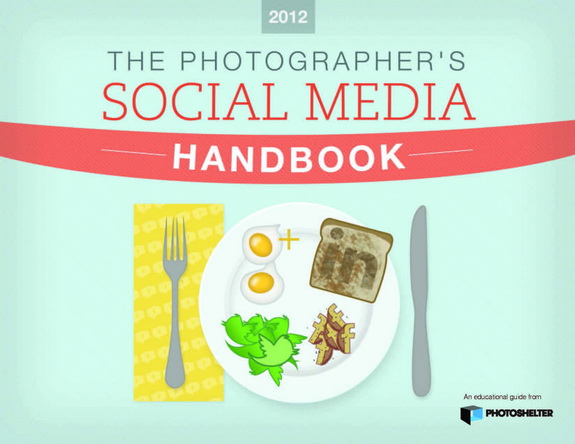PHOTOGRAPHERS. Are you getting the type of results you want from social-media marketing? If not, maybe it’s time to try new tactics or focus on a different platform. To give you some facts and inspiration, PhotoShelter recently released an updated, two-part version of their e-book on social media for photographers.
The 2012 edition of “The Photographer’s Social Media Handbook” covers best practices for using Facebook, Google+, LinkedIn, and Twitter to enhance your marketing efforts and get noticed by potential clients. Part 1 (44 pages) covers Facebook and Google+. Part 2 (26 pages) covers LinkedIn, Twitter, and other social media platforms that matter.
The first edition of this social media handbook was published in 2010. This updated version talks about major changes that have occurred and looks ahead to changes anticipated this year. You will see why you need different strategies for each social-media site, and learn how to measure your results.
“The Photographer’s Social Media Handbook” includes interviews with photographers who attracted significant online followings. These photographers provide real-world tips on what works and what doesn’t. They agree that developing a strategy is particularly important, “There must be a method to the madness. Blindly posting and interacting with potential customers will get you nowhere. You first need to ask yourself: “What do I want to accomplish and can this platform help me get there?”
Here’s a brief overview of how photographers can benefit from using four of the most popular social-media platforms.
Part 1: Facebook and Google+
Facebook is a daily-destination website whereas your personal website is not. It has also become an accepted vehicle for business marketing. Developing a Facebook Page dedicated to your photography business can help build your brand and makes it easier for potential customers to find you. You can use your page to show your photos, ask for opinions, or offer discounts and promotions.
Google+ is a fast-growing social-media platform that could be considered as an extension of Google itself. Your success with Google+ could directly impact your search-engine optimization (SEO) efforts. Google+ is built for photo-sharing, and accommodates viewing, managing, and editing multimedia.
Part 2: LinkedIn, Twitter, and Other Platforms
LinkedIn can be great for marketing photography services to businesses because it includes more than 54,000 people who identify themselves as photo editors, 28,000+ art buyers, 580,000+ graphic designers, and 644,000+ art directors. LinkedIn can also help you establish yourself as a reputable source and make connections with people who can vouch for your business ethic and photography.
Twitter connects businesses to customers in real-time. It can help you spread awareness to people who may not know about you, drive signups for your newsletter, get feedback for your images and services, and announce news, special promotions, achievements, and events.
The “Photographer’s Social Media Handbook” advises that “Social media is not something you should pay attention to once a week or only on the weekends. Create consistent times to post, share, and interact with users. This will help grow your following, and increase your chances for solid business opportunities.”
Photographer Bryan Formhals notes that, “You don’t have to be on every platform! Choose the few that you enjoy and commit to them.”
PhotoShelter is a leader in portfolio websites and business tools for serious photographers. It offers a host of social-sharing tools that can help you promote your work via multiple platforms.
LINKS
The 2012 Photographer’s Social Media Handbook

